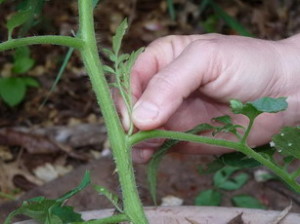Elephant Journal loves Bryant and the Urban Farm Co. mission. They use beetle kill whenever they can get it for their boxes. We don’t like plastic tarping for gardening. Plastic is bad. So bad! Just awful! We hate plastic. Anyways! This helpful lesson and others can be found here. ~ ed.
Growing your own tomatoes can either be a sweet, juicy success or a bitter, shriveled disappointment. Make sure you end up with the former:
1) Choosing Transplants: When purchasing your transplants, make sure they are high quality plants. Ask if they have been “hardened” (prepared to be planted outside). You want the plant to be about 6-10” tall, have a thick stem, and dark green leaves. The ideal tomato plant is almost as wide from leaf to leaf as it is tall. We suggest choosing a plant that isn’t already producing flowers and fruit. Do your best to avoid buying “root bound” plants. Here are some varieties we recommend:
Cherokee Purple (heirloom)
New Girl (hybrid)
Big Beef (heirloom)
Black Krim (heirloom)
Sun Gold (hybrid)
Supersweet 100 (hybrid)
Striped German (heirloom)
2) Location: Pick your location carefully. You want your plants to have access to full sun and warm soil. If you have planted tomatoes before, make sure you are rotating them to avoid soil-borne diseases and soil depletion. If you can, do a four-year crop rotation.
3) Timing: Plant your tomato transplants well after the danger of a frost has past. Nighttime temperatures should be in the low to mid 40s, and daytime temperatures in the high 50s. A week of cool daytime temps (below 55) will permanently stunt plants, reducing yields. We recommend planting around May 20th—don’t plant before the 15th unless you’re using a Wall of Water.
4) Plant Deep: Plant in rich soil. Dig a deep hole for transplanting. Place the plant deep in the hole, and bury the stem of the tomato plant deeper than it was growing in the pot. You can plant it up to three or four branches from the top because roots will develop from the stem. Consider applying a water-soluble organic starter fertilizer, which will help stimulate growth and help reduce transplant shock.
5) Water: Water regularly and deeply. Irregular watering (missing a week and trying to make up for it) can lead to blossom end-rot and fruit cracking. When the fruits are dehydrated, then receive a rush of moisture, the fruits will crack and the plant is more susceptible to problems. A layer of grass clippings, straw or compost as mulch on the soil will conserve moisture and keep the soil temperature even.
Tomatoes (and peppers and eggplant) need water most critically during flowering and fruiting. However, don’t over do it.The tomato family has a lower water requirement than many vegetables and plants are often over-watered in the typical home garden.
Water the soil, not the plants. Tomatoes are more susceptible to disease when they get wet. Symptoms of blight, or a fungal disease on the plant, often start as tiny black spots on lower leaves.
6) Keep Them Off the Ground: If you don’t have a trellis, we suggest caging your tomatoes. Find the largest cages you can find and put them over your tomato before it’s too large to fit it over the top. With cages, you don’t have to prune the suckers. The plants will simply sprawl out in the cage, but will take up several square feet (as opposed to just one square foot on a trellis).
7) Trellising, Staking, and Pruning: If you want to grow tomatoes on a trellis, it’s possible to keep them growing upwards without taking up too much space in your garden. The key is to continually prune your tomatoes by removing the “suckers.”
Here is a picture of suckers; they’re the stems that grow in the “armpit” between the main stems and the side stems.
Pinch off the suckers as the plant grows upwards. Suckers will eventually turn into new main branches and cause the plant to bush out. Suckers take a lot of energy from the plant, which you want to devote toward the one main stem growing up the trellis. We suggest pruning suckers off until the tomato is climbing up the trellis about a foot. At that point, it is actually ok to let a couple suckers fan throughout the trellis a bit more.
Beans, peas, and hops are “self-climbers,” but tomatoes must be guided between the trellis netting a bit. It helps to use small twine or ties to keep the plant to the trellis when it’s young. It may take a bit of training for the main stem to “reach” back toward the trellis.
It’s possible to stake your tomatoes with a large stake at least 6-7′ tall, using the same sucker-pruning method described above. Use string or twine to keep the main stem to the stake as it grows upwards.
8) Maintenance: Remove the lower leaves. The leaves closest to the ground are the oldest, and will be shaded by top growth as the plant grows. Removing them helps prevent disease and provides better air circulation. Remove them when the bottom leaves turn yellow.
9) Prepare for Fall Frost: Before a frost, pick ripening fruit and green tomatoes. Remove the stems. Save only blemish-free fruits for ripening indoors. Place them in a cardboard box or brown paper bag to ripen.
Author: Bryant Mason
Editor: Emily Bartran
Photo: Flickr












Read 0 comments and reply